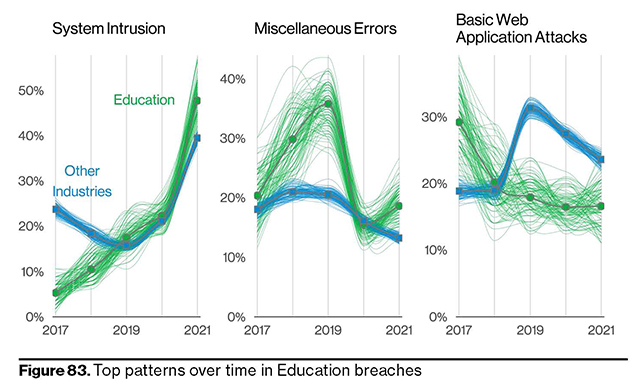Report: Ransomware Data Breaches' Growth Last Year Equal to Last 5 Years Combined
- By Kristal Kuykendall
- 05/26/22
Data breaches resulting from ransomware attacks jumped by 13% last year — equal to the last five years’ increase combined — and are impacting more education organizations than ever, according to the recently released Verizon Business 2022 Data Breach Investigations Report.
The research is based on analysis of 914,547 incidents, 234,638 breaches, and 8.9 TBs of cybersecurity data since the first DBIR 15 years ago, Verizon said; the incident information is from Verizon Business data as well as 87 partners in the telecommunications and cybersecurity industries.
Researchers analyzed 23,896 cyber incidents last year, with 5,212 of those being data breaches, the report said.
In the education sector, DBIR researchers analyzed 1,241 cyber incidents, with 282 of those resulting in data breaches.
Key Findings Among Education Cybersecurity Incidents:
- 139 of the data breaches included the use of malware.
- 123 of the data breaches were initiated by system intrusions.
- 55 of the data breaches were initiated by basic web application attacks
- 51 breaches resulted from from miscellaneous errors by humans.
- Malware was found to in 437 of all education cyberattacks.
- 790 of all cyberattacks were classified as hacking attempts.
- 643 of all cyberattacks were classified as denial of service attacks.
- 95% of all cyberattacks targeted the education organization’s servers.
- 75% of cyber incidents were initiated by external threat actors.
- 95% of breaches were motivated by threat actors seeking data for financial gain.
- 63% of the data compromised was classified as personal, identifiable information.
- 41% of data compromised was credentials.

The DBIR report noted that about four in five breaches is attributable to organized crime, adding that human error — primarily, misconfigured cloud storage — continues to be a dominant trend and is responsible for 13% of breaches. Internal sources accounted for just 18% of cyber incidents, the report said.
The full report is available on the Verizon Business website.
About the Author
Kristal Kuykendall is editor, 1105 Media Education Group. She can
be reached at [email protected].